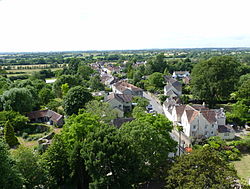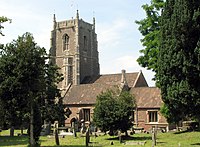Difference between revisions of "Iron Acton"
(Created page with "{{Infobox town |name=Iron Acton |county=Gloucestershire |picture=Iron.Acton.High.Street.West.REDH.JPG |picture caption=Iron Acton High Street, from the church tower |os grid r...") |
|||
| Line 16: | Line 16: | ||
|website=[http://www.ironactonvillage.info/ IronActonParish.info] | |website=[http://www.ironactonvillage.info/ IronActonParish.info] | ||
}} | }} | ||
| − | '''Iron Acton''' is a village in [[Gloucestershire]], about two miles [[Yate]] and nine miles north-east of the centre of [[Bristol]], the county's great city, at its southern border. The B4058 road used to pass through the village but now by-passes it just to the north. | + | '''Iron Acton''' is a village in [[Gloucestershire]], about two miles west of [[Yate]] and nine miles north-east of the centre of [[Bristol]], the county's great city, at its southern border. The B4058 road used to pass through the village but now by-passes it just to the north. |
The manor house is [[Acton Court]], a moated manor house. | The manor house is [[Acton Court]], a moated manor house. | ||
| Line 25: | Line 25: | ||
==Manor== | ==Manor== | ||
| − | The manor of Iron Acton was held by the ''de Acton'' family, which took its name from the manor. The family expired in the male line on the death of John IV de Acton in 1362 and the manor was inherited through his aunt Matilda (or Maud) by the Poyntz family<ref>Maclean, 1885, p.131</ref> of [[Curry Mallet]] in Somerset. The Poyntz family had their seat at Iron Acton for many generations and rose to prominence under the Tudor monarchs. Sir Nicholas Poyntz (1510-1556) was a prominent courtier during the latter part of the reign of King Henry VIII (1509-1547) and his portrait drawing by Hans Holbein the Younger survives in the Royal Collection at [[Windsor Castle]]. Sir Nicholas added the east wing to Acton Court in 1538 for a visit by the King. Sir Robert Poyntz (d.1666), KB, MP for Gloucestershire and High Sheriff of Gloucestershire was the last in the male line of Poyntz of Iron Acton. He left no male progeny, only two daughters and co-heiresses, Grissel Poyntz and Margareta Poyntz. | + | The manor of Iron Acton was held by the ''de Acton'' family, which took its name from the manor. The family expired in the male line on the death of John IV de Acton in 1362 and the manor was inherited through his aunt Matilda (or Maud) by the Poyntz family<ref>Maclean, 1885, p.131</ref> of [[Curry Mallet]] in [[Somerset]]. The Poyntz family had their seat at Iron Acton for many generations and rose to prominence under the Tudor monarchs. Sir Nicholas Poyntz (1510-1556) was a prominent courtier during the latter part of the reign of King Henry VIII (1509-1547) and his portrait drawing by Hans Holbein the Younger survives in the Royal Collection at [[Windsor Castle]]. Sir Nicholas added the east wing to Acton Court in 1538 for a visit by the King. Sir Robert Poyntz (d.1666), KB, MP for Gloucestershire and High Sheriff of Gloucestershire was the last in the male line of Poyntz of Iron Acton. He left no male progeny, only two daughters and co-heiresses, Grissel Poyntz and Margareta Poyntz. |
==Acton Court== | ==Acton Court== | ||
| Line 77: | Line 77: | ||
*Maclean, Sir John: 'Historical and Genealogical Memoir of the Family of Poyntz' (1885) | *Maclean, Sir John: 'Historical and Genealogical Memoir of the Family of Poyntz' (1885) | ||
| − | *{{cite book |last=Blair |first=Peter Hunter | + | *{{cite book |last=Blair |first=Peter Hunter |title=An Introduction to Anglo-Saxon England |year=1977 |origyear=1956 |edition=2nd |publisher=Cambridge University Press |location=Cambridge & London |isbn=0-521-29219-0 |pages=258–259}} |
*{{Pevsner|page=276–278}} | *{{Pevsner|page=276–278}} | ||
Latest revision as of 18:42, 30 November 2019
| Iron Acton | |
| Gloucestershire | |
|---|---|
 Iron Acton High Street, from the church tower | |
| Location | |
| Grid reference: | ST680835 |
| Location: | 51°32’56"N, 2°27’47"W |
| Data | |
| Population: | 1,346 (2011) |
| Post town: | Bristol |
| Postcode: | BS37 |
| Dialling code: | 01454 |
| Local Government | |
| Council: | South Gloucestershire |
| Parliamentary constituency: |
Thornbury and Yate |
| Website: | IronActonParish.info |
Iron Acton is a village in Gloucestershire, about two miles west of Yate and nine miles north-east of the centre of Bristol, the county's great city, at its southern border. The B4058 road used to pass through the village but now by-passes it just to the north.
The manor house is Acton Court, a moated manor house.
The name of the village bear s the prefix "iron" from the iron that used to be mined near the village. "Acton" is the Old English ac tun: 'oak village/farmstead'.[1] Still today there is an oak wood in the village beside the River Frome.
The wider civil parish also includes the smaller villages of Latteridge and Engine Common.
Contents
Manor
The manor of Iron Acton was held by the de Acton family, which took its name from the manor. The family expired in the male line on the death of John IV de Acton in 1362 and the manor was inherited through his aunt Matilda (or Maud) by the Poyntz family[2] of Curry Mallet in Somerset. The Poyntz family had their seat at Iron Acton for many generations and rose to prominence under the Tudor monarchs. Sir Nicholas Poyntz (1510-1556) was a prominent courtier during the latter part of the reign of King Henry VIII (1509-1547) and his portrait drawing by Hans Holbein the Younger survives in the Royal Collection at Windsor Castle. Sir Nicholas added the east wing to Acton Court in 1538 for a visit by the King. Sir Robert Poyntz (d.1666), KB, MP for Gloucestershire and High Sheriff of Gloucestershire was the last in the male line of Poyntz of Iron Acton. He left no male progeny, only two daughters and co-heiresses, Grissel Poyntz and Margareta Poyntz.
Acton Court
Acton Court on Latteridge Lane is the historic manor house of the manor of Iron Acton. It is a Tudor building, with later restorations. In the 16th century Nicholas Poyntz added the east wing to the existing moated house, which addition was lavishly decorated to impress King Henry VIII who with his second wife, Anne Boleyn, visited the house in 1535 during a tour of the West Country.
Parish church
The parish church of St James the Less is a Perpendicular Gothic church of the late 14th or early 15th century. It is a Grade I listed building.[3]
The church includes a clerestory, south aisle and south chapel, two-storey north porch and three-stage bell-tower.[4] The nave and south arcade are of three bays.[4] The nave, chancel and south chapel all have wagon roofs and there is a fan vault under the tower.[4]
The church was restored in 1878–79 under the direction of the Gothic Revival architect Sir Thomas Graham Jackson.[4] The holy table has a reredos designed by Frederick Charles Eden and made in about 1930.[4] Behind the altar of the south chapel is a screen also designed by Eden.[4][3]
Poyntz Chapel
The communion table at the east end of the south aisle forms the focal point of the so-called Poyntz Chapel, which is not a separate chamber or structure. (This is not to be confused with the Poyntz Chapel, formally termed "Chapel of Jesus", built by Sir Robert Poyntz (d.1520) within St Mark's Church, Bristol.)
Against the south wall is a 16th-century canopied tomb erected for a now unknown member of the Poyntz family. Of the three heraldic escutcheons comprised within the structure two are now blank and one bears the arms of the Acton family, from which the Poyntz's inherited the manor, A fess indented. No inscription survives. The tomb was covered with many layers of whitewash until this was removed in the 19th-century restoration.
Dividing the Poyntz Chapel from the chancel are a pair of stone effigies set on slabs at floor level. The figures show an armed knight of the 14th century beside a female figure, possibly his lady, but perhaps of a slightly later date. The knight is believed to represent Sir John Poyntz (d. 21 Sept 1376), son of Sir Nicholas Poyntz.
Railway
The Midland Railway opened its Thornbury Branch Line in 1872, including Iron Acton railway station to serve the village. The London, Midland and Scottish Railway closed the station in 1944 and it was demolished in the 1960s, but the line still carries one freight train a week between a stone quarry at Tytherington and the junction at Yate with the Birmingham and Gloucester line.
A freight-only branch serving an iron mine in Frampton Cotterell joined the branch line at the station. This was closed in 1872 but a truncated section of the line served as a coal depot until closure on 10 June 1963.
Iron Acton station had a single platform and a large wooden station building. The remains of the platform survive, as does a crossing-keeper's cottage to the south of the station site.
About the village
- Acton Court
- Algars Court or Algars Manor, just south of the village, is also a Tudor house.[5]
Events and society
A May Day fair and horticultural show are held each year.
Other events are organised by Acton Aid, a community organisation working to benefit the parish of Iron Acton. Money is raised by holding social events such as the annual fireworks display and the Proms in the Meadows, and working with other parish organisations at the annual May Day fair. An example of such an event is the Victorian evening, during which local residents dressed up in Victorian era clothing for a fair on the street, which is accompanied by a brass band.
- Football: Iron Acton F.C., which plays home games on Yate Common, a mile and a half away.
There are two pubs in the village and there is no shop in the main part of the village, there is however a garage on the outskirts of the village that is open 24/7
Outside links
| ("Wikimedia Commons" has material about Iron Acton) |
References
- Maclean, Sir John: 'Historical and Genealogical Memoir of the Family of Poyntz' (1885)
- Blair, Peter Hunter (1977) [1956]. An Introduction to Anglo-Saxon England (2nd ed.). Cambridge & London: Cambridge University Press. pp. 258–259. ISBN 0-521-29219-0.
- Nikolaus Pevsner: Pevsner Architectural Guides

